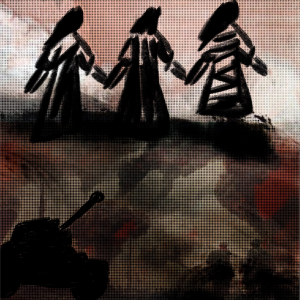The nationalisms in former Yugoslavia in the late 1980s and early 1990s seemed out of sync for many with the larger European picture. The end of the Cold War, the reintegration of Europe at first glance made the wars in Yugoslavia seem anachronistic and out of time. It is no surprise that cartoonists, commentators and observers often called the conflicts and the nationalisms as ‘backward’, ‘ancient’ and out of place. The wars have also often been forgotten in larger European narratives about post-Cold War unification, as they would appear as an anomaly.
Such perspectives ignored the strong powers of nationalism at play across Europe at the time. The project of German unification was informed by the slogan of ‘Wir sind ein Volk’ (We are one people’) which replaced the call for democracy under the slogan ‘Wir sind das Volk’ (We are the people). Similarly, in Central Europe, the initial calls for more democracy and citizen inclusion morphed into demands for a return to Europe, which had strong nationalist undercurrents. The ‘Other’ in these nationalisms, however, was the Soviet Union and its Red Army which quickly withdrew and then collapsed and could not pose a threat after the critical period in 1989/91. The anti-minority violence in Romania after the fall of Ceaușescu and the massive anti-Turkish campaign in Bulgaria in 1989 were quickly forgotten.
The dominant narrative of a liberal Europe in which nationalisms are ‘defanged’ appeared to prevail, extending with a ten-year delay after the end of the Yugoslav wars and the fall of its autocrats in Serbia and Croatia.
This period came to an end by the 2010s. Since, many have observed the rise of nationalism, sometimes called ‘new’. There has been nothing new about this nationalism. It has been marked by a) strong far right parties which campaign on exclusionary, authoritarian and nationalism/nativist platforms, b) the incorporation of many of these ideas in the political mainstream, in particular on the center right.
The only partially new feature of these nationalism is their transnationalism. Which might sound like a paradox is central. The parties on the far-right do not only cooperate; the parties, movements and groups exchange ideas, narratives and messages. These are no longer directed against neighbors, but have large civilizational enemies, making transnational communication and cooperation easier. They share a strong anti-immigrant and especially anti-Muslim orientation, they view themselves as defending not just the ‘nation’ but often a larger civilization, often described as ‘European’ or ‘Western’. At the same time, they are strongly anti-elitist, directed against ‘global elites’ but also against political and academic elites. This combination is best epitomized in the ‘great replacement’ theory which combines the fear of immigration (replacement) with the notion that this is planned by a group of global elites. The conspiracy theories during the COVID19 pandemic among the far-right also highlighted the centrality of rejecting science and ‘mainstream’ consensus.
While the regime of Viktor Orbán has claimed a central place in normalizing the far-right in Europe, it would be misleading to consider this phenomenon as being linked to Europe’s East or post-Communist states.
The strong performance of Marine Le Pen in France and the electoral victory of Georgia Meloni and her Fratelli d’Italia, as well as the strong showing of far-right parties from Spain to Finland, suggest that exclusionary nationalism is a pan-European phenomenon, with complex and multifaceted international links.
The Russian war of aggression in Ukraine has fragmented the European far-right and nationalist parties and groups. While some have continued to support Russia, such as Orbán, Vučić and the far right in Austria and Germany, others have openly sided with Ukraine, such as the national conservative government in Poland and Giorgia Meloni. For the latter, the decision to side with Ukraine was part of an effort to enter the European mainstream and for others out of the national position which posited Russia as the main threat. For pro-Russian nationalist and far right groups, the attraction either lies in the solidarity with Russia centering around religion, as in Bulgaria and Serbia, narratives of good relations and accommodation, as in Austria and Germany, or around the ‘traditional’ values Russia under Putin is supposed to represent.
The war in Ukraine has not stopped the strong performance of nationalist and far-right parties in Europe. Already the pandemic highlighted the resilience of the far right and its ability to shift to other topics than migration and preserve popular support.
If nationalisms in the Balkans during the early 1990s appeared out of sync to the larger European trajectory, today this is no longer the case. Not only has the pan-European far-right incorporated elements of the nationalist discourses from Serbia and elsewhere into its ‘DNA’, it also offers space for different nationalisms. Thus, the far right across Southeastern Europe has largely adopted the anti-immigrant position that is central to European nationalist groups. Anti-immigrant stance was marginal until recently, both as the number of migrants who stayed in the countries of the region were marginal and as there were more salient ‘Others.’ However, with the closure of the EU’s external borders, anti-immigrant positions have gained traction as immigrants have been ‘stuck’ along the EU’s frontier in Bosnia and Serbia.
Pro-Russian position has also provided the glue for some links between the far right. For example, the Austrian Freedom Party has been supporting Serbian nationalist positions on Kosovo and Bosnia and sought ties with nationalist groups and parties in Republika Srpska and Serbia. Despite traditional anti-Serb and anti-immigrant positions among the Austrian far right, the party’s support for Putin brought about the strategic rapprochement. Another link is anti-Muslim position that have long been central to Balkan nationalist groups and have been adopted across the continent. A final link is the alliance of autocrats. Orbán has promoted ties with regimes in Southeastern Europe, first building relations with the autocratic regime of Nikola Gruevski in North Macedonia, followed by good relations with Aleksandar Vučić, Milorad Dodik and Janez Janša, all characterized by similar authoritarian and nationalist positions.
While it would be misleading to identify a coherent pan-European far-right, parties and groups on the far-right have formed networks based on organizational cooperation, the circulation of ideas and the emergence of civilizationalism as an ideological framework of the far right. Civilisationism frames key issues, such as immigration and gender not just as threats to the respective nation, but to the larger “civilization”. This civilization is often undefined, but centers on Europe and its Christians/Jewish population.
The other is not just the non-European migrant, but also often elites in Europe and others associated with the EU and liberal values. From Putin’s notion of “Gayropa” to Orbàns rhetoric against Brussels this concept seeks to both condemn and other ideas of gender equality and LGBTQI+ rights and offer an alternative Europe, based on ‘traditional values’ that places nation and family of this world view, both idealized in an ahistorical perspective.
One consequence of this pan-European nationalism has been the reconfiguration of a far-right attitude to the European Union. The idea of leaving the EU is no longer attractive, not only due to the cautionary tale of Brexit. Instead, far-right groups promote changing Europe from within. Brussels still serves as a by-word for bureaucracy, liberal and technocratic elites, as used by populists from left and right for decades. Yet, European nationalist parties and groups claim to replace these elites with their majorities. While this allows the far right within the EU to formulate a civilizational project in the institutional framework of the EU, it has not a similar effect in the Western Balkans. Nationalist parties largely remain Eurosceptic, because the EU in the context of the accession process is seen as a greater threat to the groups’ core messages, such as hostility to LGBTQI+ rights, historical revisionism, and authoritarianism. While the regime of Aleksandar Vučić has highlighted the compatibility of EU integration (at least formally) with those, Euroscepticism remains more pronounced among the nationalist and far-right groups outside the EU in the Western Balkans than within.
If extreme nationalist movements and parties in the Western Balkans appeared anachronistic in the 1990s, they are very timely today in the larger European context. As such, they are part of a mutual learning process and exchange of ideas on Europe’s far right.
This makes the rise of the far-right or nationalism neither inevitable or unstoppable, but it means that there is much more tolerance and acceptance in the larger international context for such positions. A central feature is the mainstreaming of nationalist and far-right ideas by centrist parties, esp. at the centre right, which ensured that these trends are not restricted to parties that openly endorse far right policies. The bordering of Europe through an increasingly impenetrable and militarized border follows the logic of the civilisationism. The centrality of borders for Europe has also meant that the Balkans have become an important frontier zone of the EU, which has two consequences. First, it allows the region’s nationalisms to define themselves as Europe’s border guards, a theme that is already strongly anchored in nationalist narratives from the celebration of Skenderbeg among Albanians to the concept of the Antemurale Christianitatis popular in Croatian, Hungarian and Polish nationalism, to the anti-Muslim narratives of Serbian and Bulgarian nationalisms. Second, it also allows authoritarian populist regimes to gain legitimacy in the EU as effective guardians of the EU.
__________________________
©
Disclaimer: “This publication has been produced with the support of Heinrich Böll Stiftung, Tirana Office. Its contents are the sole responsibility of the author and “Shota” magazine and do not necessarily reflect the views of the donor.”











